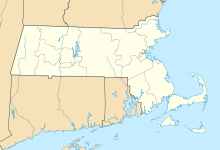Gay Head Light

Gay Head Light
|
|
| Location | Aquinnah, Massachusetts |
|---|---|
| Coordinates | 41°20′54.4″N 70°50′5.8″W / 41.348444°N 70.834944°WCoordinates: 41°20′54.4″N 70°50′5.8″W / 41.348444°N 70.834944°W |
| Year first constructed | 1799 |
| Year first lit | 1856 (current structure) |
| Automated | 1960 |
| Foundation | Granite stone on cement |
| Construction | Brick and sandstone |
| Tower shape | Conical |
| Markings / pattern | Red brick with black lantern |
| Focal height | 170 feet (52 m) |
| Original lens | First order Fresnel lens |
| Current lens | DCB-224 |
| Range | White 24 nautical miles (44 km; 28 mi) Red 20 nautical miles (37 km; 23 mi) |
| Characteristic |
|
| Fog signal | none |
| Admiralty number | J0476 |
| USCG number |
1-620 |
|
Gay Head Light
|
|
| Location | Lighthouse Rd., Aquinnah, Massachusetts |
| Area | 2 acres (1ha) |
| Built | 1856 |
| MPS | Lighthouses of Massachusetts TR |
| NRHP Reference # | 87001464 |
| Added to NRHP | June 15, 1987 |
1-620
Gay Head Light is a historic lighthouse located on Martha's Vineyard westernmost point off of Lighthouse Road in Aquinnah, Massachusetts.
When the first Congress of the newly formed United States government met in 1789, one of its first acts was to assume responsibility for lighthouses and other aids to navigation along the country's coastline. For the next twenty-five years, design and construction of new lighthouses were authorized by Congress. The location, size, design, and construction of each lighthouse was considered of such vital importance, that the decision-making process involved the highest officials, including the President.
In 1796, Massachusetts State Senator, Peleg Coffin, requested a lighthouse be installed on Martha's Vineyard above the Gay Head cliffs overlooking a dangerous section of underwater rocks known as "Devil's Bridge." Senator Peleg's request to his Congressman in Washington was substantiated by the maritime traffic navigating the waters between Gay Head and the Elizabeth Islands, which was reported in a late 1800s Massachusetts study at 80,000 vessels annually. As the state representative for Nantucket, Peleg Coffin also had the whaling industry interests of Nantucket in mind. The Gay Head lighthouse was authorized in 1798 by the United States Congress during the Presidency of John Adams. This authorization was to help facilitate safe passage for vessels passing through the hazardous Vineyard Sound waters near the Gay Head cliffs.
In 1799 The Commonwealth of Massachusetts deeded two acres and four rods to the Federal Government for the purpose of building a lighthouse overlooking the clay cliffs and Devil's Bridge. During the same year, President John Adams approved a contract with Martin Lincoln of Hingham, Massachusetts, to build a 47-foot octagonal wooden lighthouse tower on a stone base (including light room); a 17 x 26-foot wooden keeper's house; a whale oil storage building, and various other outbuildings. This wooden octagonal lighthouse is illustrated in the c1800 woodcut shown below left. Charles Edward Banks, who published "The history of Martha's Vineyard" in 1911 wrote, "This wooden tower lasted sixty years, and the site of it, nearer the brow of the cliffs than the present one, can be seen yet in a circular elevation of the soil. The planned 1799 installation of a Gay Head lighthouse, along with a full-time lighthouse Superintendent and his family, represented the first "Whiteman" homestead established in Gay Head. During the planning process of designing and building the first Gay Head lighthouse in 1799, there was some concern expressed about the impact of a Whiteman settlement in Gay Head. William Rotch, a supplier of whale oil, wrote a letter to Congress on September 28, 1799. Rotch's letter recommended that Captain Owen Hillman, of Martha's Vineyard, be appointed lighthouse Keeper. Most of the letter, however, discussed the subject of how a certain aspect of Whiteman's culture may negatively impact the indigenous Wampanoag community. A section of Rotch's letter states: "As this light house is in a neighborhood of peaceful natives who are industrious and temperate, it is the fear of some of the most considerate that the Superintendent [Keeper of the lighthouse] may injure them by selling them liquor and, feeling much concern for that people, we hope it will meet thy views to have him put under positive restrictions thereupon."
...
Wikipedia

